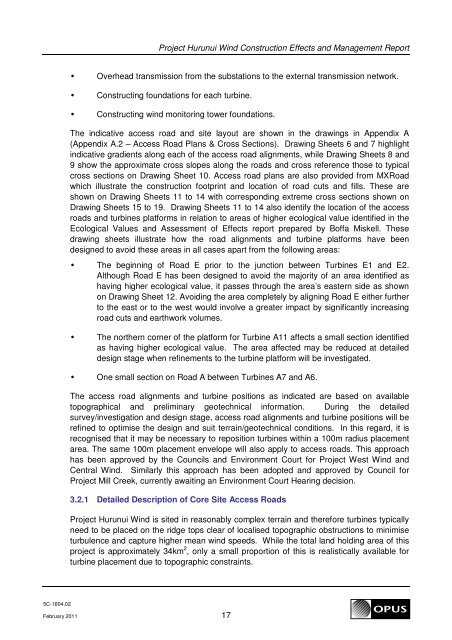Project Hurunui Wind Construction and Project Overview
Project Hurunui Wind Construction and Project Overview
Project Hurunui Wind Construction and Project Overview
Create successful ePaper yourself
Turn your PDF publications into a flip-book with our unique Google optimized e-Paper software.
<strong>Project</strong> <strong>Hurunui</strong> <strong>Wind</strong> <strong>Construction</strong> Effects <strong>and</strong> Management Report<br />
• Overhead transmission from the substations to the external transmission network.<br />
• Constructing foundations for each turbine.<br />
• Constructing wind monitoring tower foundations.<br />
The indicative access road <strong>and</strong> site layout are shown in the drawings in Appendix A<br />
(Appendix A.2 – Access Road Plans & Cross Sections). Drawing Sheets 6 <strong>and</strong> 7 highlight<br />
indicative gradients along each of the access road alignments, while Drawing Sheets 8 <strong>and</strong><br />
9 show the approximate cross slopes along the roads <strong>and</strong> cross reference those to typical<br />
cross sections on Drawing Sheet 10. Access road plans are also provided from MXRoad<br />
which illustrate the construction footprint <strong>and</strong> location of road cuts <strong>and</strong> fills. These are<br />
shown on Drawing Sheets 11 to 14 with corresponding extreme cross sections shown on<br />
Drawing Sheets 15 to 19. Drawing Sheets 11 to 14 also identify the location of the access<br />
roads <strong>and</strong> turbines platforms in relation to areas of higher ecological value identified in the<br />
Ecological Values <strong>and</strong> Assessment of Effects report prepared by Boffa Miskell. These<br />
drawing sheets illustrate how the road alignments <strong>and</strong> turbine platforms have been<br />
designed to avoid these areas in all cases apart from the following areas:<br />
• The beginning of Road E prior to the junction between Turbines E1 <strong>and</strong> E2.<br />
Although Road E has been designed to avoid the majority of an area identified as<br />
having higher ecological value, it passes through the area’s eastern side as shown<br />
on Drawing Sheet 12. Avoiding the area completely by aligning Road E either further<br />
to the east or to the west would involve a greater impact by significantly increasing<br />
road cuts <strong>and</strong> earthwork volumes.<br />
• The northern corner of the platform for Turbine A11 affects a small section identified<br />
as having higher ecological value. The area affected may be reduced at detailed<br />
design stage when refinements to the turbine platform will be investigated.<br />
• One small section on Road A between Turbines A7 <strong>and</strong> A6.<br />
The access road alignments <strong>and</strong> turbine positions as indicated are based on available<br />
topographical <strong>and</strong> preliminary geotechnical information. During the detailed<br />
survey/investigation <strong>and</strong> design stage, access road alignments <strong>and</strong> turbine positions will be<br />
refined to optimise the design <strong>and</strong> suit terrain/geotechnical conditions. In this regard, it is<br />
recognised that it may be necessary to reposition turbines within a 100m radius placement<br />
area. The same 100m placement envelope will also apply to access roads. This approach<br />
has been approved by the Councils <strong>and</strong> Environment Court for <strong>Project</strong> West <strong>Wind</strong> <strong>and</strong><br />
Central <strong>Wind</strong>. Similarly this approach has been adopted <strong>and</strong> approved by Council for<br />
<strong>Project</strong> Mill Creek, currently awaiting an Environment Court Hearing decision.<br />
3.2.1 Detailed Description of Core Site Access Roads<br />
<strong>Project</strong> <strong>Hurunui</strong> <strong>Wind</strong> is sited in reasonably complex terrain <strong>and</strong> therefore turbines typically<br />
need to be placed on the ridge tops clear of localised topographic obstructions to minimise<br />
turbulence <strong>and</strong> capture higher mean wind speeds. While the total l<strong>and</strong> holding area of this<br />
project is approximately 34km 2 , only a small proportion of this is realistically available for<br />
turbine placement due to topographic constraints.<br />
5C-1604.02<br />
February 2011 17
















